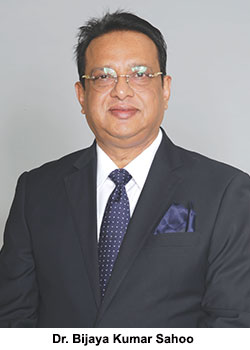Standards-setting & accreditation for schools – Dr. Bijaya Kumar Sahoo
 Dr. Bijaya Kumar Sahoo is founder-chairman of the Bhubaneswar (Odisha)-based SAI International Group comprising four institutions — the SAI International School, SAI International Residential School, Sai Angan preschool and Sai International College of Commerce — with an aggregate enrolment of 5,260 students and 756 teachers. Dr. Sahoo is also Advisor with ministerial rank of the Odisha Adarsha Vidyalaya Sangathan, tasked with the mission to establish 314 CBSE-affiliated English-medium government schools — one in every administrative block of Odisha.
Dr. Bijaya Kumar Sahoo is founder-chairman of the Bhubaneswar (Odisha)-based SAI International Group comprising four institutions — the SAI International School, SAI International Residential School, Sai Angan preschool and Sai International College of Commerce — with an aggregate enrolment of 5,260 students and 756 teachers. Dr. Sahoo is also Advisor with ministerial rank of the Odisha Adarsha Vidyalaya Sangathan, tasked with the mission to establish 314 CBSE-affiliated English-medium government schools — one in every administrative block of Odisha.
Read: Odisha Adarsha Vidyalaya Sangathan: Revolutionising public schooling in India
Are you satisfied with NEP 2020’s proposals for regulating schools?
For the first time in Indian education history, NEP 2020 has focused on learning outcomes rather than input-based standards for school education. The proposed State School Standards Authority (SSSA) will ensure accountability and improve overall quality of K-12 education. Most important, if implemented as proposed, it will ensure all schools — public and private — maintain minimum quality standards. NEP 2020 states that all public and private schools will be assessed and accredited on common criteria. In the long run greater accountability will improve overall standards.
The policy separates the regulatory and operational functions of government. Is this possible with government agencies still executing all roles?
NEP 2020 has separated the functions of policy formulation, operations and regulation and entrusted them to different government agencies. While the State Education Department is tasked with policy formulation, the Directorate of Education is in charge of running government schools and SCERT will set academic standards. The success of this three-tier system will depend on how effectively state governments are able to maintain the independence of these institutions.
Won’t the State School Standards Authority (SSSA) tighten government regulation of private schools?
An ‘independent’ SSSA is mandated with regulating public and private schools and monitor maintenance of minimum common standards. Careful selection of SSSA members is of paramount importance for maintaining its independence. Otherwise, it will end up overregulating private and underregulating public, schools.
All schools are obliged to post extensive information on the SSSA and institutional websites.
Doesn’t this NEP 2020 provision violate institutional privacy?
While self-disclosure of all institutional information by schools will ensure transparency, regulators have to safeguard schools against harassment and misuse of disclosed information. NEP 2020 proposes a National Assessment Centre (PARAKH) to conduct numerous examinations.
What’s your comment?
The National Assessment Centre for Performance Assessment, Review and Analysis of Knowledge for Holistic Development — PARAKH — has been set up to conduct exams for classes III, V and VIII in addition to classes X and XII board exams. Though this will ensure better learning outcomes, there’s the danger that too many exams will stress out children, especially in their formative years, teachers and parents.
What are the major implementation roadblocks confronting NEP 2020?
The success of NEP 2020 will depend on adherence to timelines in formulating regulations, validating processes and taking corrective action if required, during implementation. In my opinion, the biggest roadblock is funding. NPE 1986 recommended raising public spending on education to 6 percent of GDP, but over the past 34 years national spending has not exceeded 3.5 percent of GDP. Moreover, successful implementation of NEP 2020 requires a complete transformation in the mindset of policy makers and regulatory agencies which will take time. There is also fear that the new regulations and regulatory authorities established by NEP 2020 mayprompt protests and litigation from private school stakeholders, which will delay implementation.
Is there any important area of school regulation which NEP 2020 has failed to address?
I believe NEP 2020 should have included the following initiatives to ensure better and faster transformation of Indian education:
• Funding. Promoting education institutions is a capital intensive endeavour requiring large capital infusion in the form of debt, debt instruments and quasi-equity. NEP 2020 should have provided for equity funding and investment in private education by Real Estate Investment Trusts (REITs), Infrastructure Investment Trust (InvIT) and Private Equity (PE).
• Three Tier Model. This model adopted by most developed nations mandates a property company to build education infrastructure, an operating company to manage infrastructure and services, and society/ trust to manage education institutions. Endorsement of this model by NEP 2020 would have facilitated establishment of education institutions of global standards in our country.
• Grievance redressal and appellate mechanism. To reduce litigation, the policy should have included a detailed, well-defined grievance redressal and appellate mechanism for public and private schools.
• Central and state education boards. A provision in NEP 2020 to synchronise uniformity between the Central and state education boards would have paved the way for one nation, one curriculum and common standards.
Read: Implementing NEP 2020: Expert advice for central government
Also read: 50 Leaders who can revive Indian education – Dr. Bijaya Kumar Sahoo

















Add comment